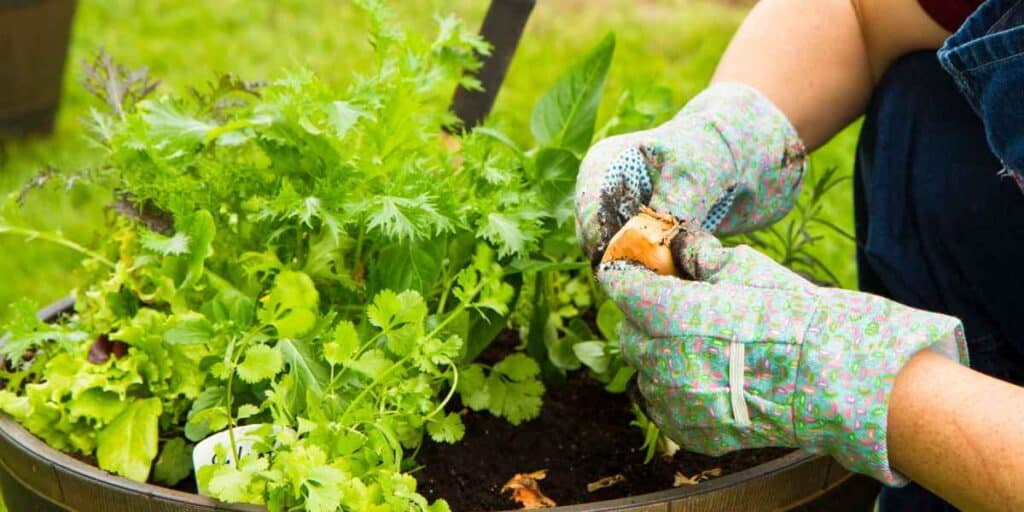Herb Companion Planting : Best Combinations for Planting Together

Introduction
Herb companion planting is like making good friends stay close to each other. Many gardeners know that some plants help others grow better when planted nearby. This is called companion planting, and it works really well with herbs.
Think about it – in small spaces like balconies or window gardens, wouldn’t it be nice if herbs could help each other grow? That’s exactly what happens in companion planting. Some herbs grow stronger, smell better, and even taste better when they have the right plant friends nearby.
Many people growing herbs at home don’t know which herbs make good partners. Some herbs are very friendly and help others grow well. But some herbs don’t like growing together at all! Just like some people don’t get along well, some herbs also need their own space.
This guide will show which herbs grow well together and which ones need to be kept apart. After reading this, anyone can create perfect herb combinations in their home garden. Whether growing in pots or small garden spaces, these tips will help herbs grow healthier and give more leaves for cooking. If you are new to herb gardening world, then read our comprehensive guide to herb gardening before taking up companion planting.
Understanding Herb Companion Planting

Before learning which herbs grow well together, let’s understand why some herbs make good partners. This will help make better choices when planting herbs at home.
How Herbs Help Each Other
- Some herbs keep away harmful insects
- Tall herbs give shade to smaller ones
- Strong-smelling herbs protect weak ones
- Some herbs make soil better for others
Space Saving Benefits
- More herbs in same space
- Better use of pot depth
- Tall and short herbs share space
- Saves money on pots and soil
Natural Pest Control
- Less insects problems
- No need for chemical sprays
- Healthy plants fight diseases better
- Good insects come to garden
Important Things to Think About
Plant Sizes
- Some herbs grow very tall
- Others stay small and bushy
- Tall ones should not cover small ones
- Give enough space to grow
Water Needs
- Some herbs need lots of water
- Others like less water
- Must group similar water-needing herbs
- Helps in easy watering
Sunlight Requirements
- Some herbs love full sun
- Others like partial shade
- Plant sun-loving herbs together
- Keep shade-loving herbs separate
These basic things are very important for successful herb companion planting. When we understand these points, choosing right herb partners becomes much easier.
Best Herb Combinations

Now let’s see which herbs grow well together. Some herbs make great garden friends while others need their own space. Here are some of the best herb combinations that work really well in home gardens.
Basil Partnerships: Good Friends of Basil:
- Parsley
- Both need regular watering
- Like same amount of sunlight
- Plant basil in middle, parsley around it
- Helps keep away flies and mosquitoes
- Oregano
- Makes basil smell stronger
- Protects from garden pests
- Plant oregano on one side of basil
- Both can share same pot
- Cilantro
- Same water and sun needs
- Both like rich soil
- Good for small pots
- Plant 6 inches apart
- Chives
- Improves basil taste
- Keeps harmful insects away
- Takes very little space
- Can grow all around basil
Not Good with Basil:
- Sage
- Takes away too much water
- Different soil needs
- Makes basil grow weak
- Better to plant separately
- Thyme
- Needs less water than basil
- Different soil type
- Can make basil dry
- Keep in different pots
- Rosemary
- Too strong smell for basil
- Different water needs
- Makes basil leaves less tasty
- Plant far from basil
Mint Combinations
Remember: Mint grows very fast and strong!
Good Mint Partners:
- Oregano
- Strong enough to handle mint
- Same water needs
- Both spread well
- Good in large pots
- Chives
- Works well with mint’s growth
- Can grow between mint plants
- Same water needs
- Easy to maintain together
- Lemon Balm
- From same plant family
- Similar growing habits
- Both like same conditions
- Good pot partners
Keep Away from Mint:
- Small herbs like parsley
- Mint will take over
- Parsley becomes weak
- No space to grow
- Basil
- Gets covered by mint
- Cannot compete for space
- Different soil needs
- Basil becomes weak
- Slow-growing herbs
- Mint grows too fast
- Takes all nutrients
- No space for others
- Better separate
Other Popular Pairs
Rosemary Friends:
- Sage
- Both like dry soil
- Need less water
- Similar height
- Perfect sunny spot partners
- Thyme
- Same water needs
- Both like well-drained soil
- Good ground cover mix
- Share nutrients well
- Oregano
- Good sun partners
- Similar soil needs
- Both drought-friendly
- Strong herbs together
All these combinations work well in pots and small spaces. But always watch plants for few days after planting together. Some herbs might need changes in their position or care. Most importantly, start small and add more herbs as you learn how they grow together.
Growing Tips for Herb Combinations
For herbs to grow well together, they need proper care. Here are simple tips to make herb combinations grow better.
Planting Guide Pot Sizes
- Small groups (2-3 herbs)
- At least 12-inch wide pot
- 8-inch deep minimum
- Must have drainage holes
- One big hole better than many small
- Bigger groups (4-5 herbs)
- 16-inch or bigger pot
- 12-inch depth needed
- Use plastic or clay pots
- Heavy pots stay stable
Space Between Plants
- Tall herbs need 12 inches space
- Medium herbs need 8 inches
- Small herbs need 4-6 inches
- Leave space for growing bigger
Soil Requirements
- Use good quality potting mix
- Add some cocopeat
- Mix little compost
- Soil should not be too tight
Watering Tips
- Morning watering is best
- Check top soil before watering
- Water base of plants
- Different herbs, different needs:
- Basil, Parsley: Regular water
- Rosemary, Thyme: Less water
- Mint: Medium water
Sunlight Management
- Most herbs need 4-6 hours sun
- Morning sun is best
- Protect from strong afternoon sun
- Arrange pots:
- Tall herbs at back
- Short herbs in front
- Creeping herbs on sides
Fertilizing Guide
- Once every month is enough
- Use organic fertilizer
- Don’t give too much
- Signs plants need food:
- Yellow leaves
- Slow growth
- Less leaves
- Weak stems
Special Care Tips
- Remove dead leaves
- Cut flowers when they come
- Keep checking for insects
- Clean leaves sometimes
- Turn pots weekly for even growth
Following these care tips makes herb combinations grow much better. Remember, herbs growing together need little more attention than single herbs.
Common Problems and Solutions
Even when herbs grow well together, some problems can come. But don’t worry – most problems have easy solutions. Here are common issues people face with herb combinations and how to fix them.
Competition Issues Problems:
- One herb growing too fast
- Small herbs getting covered
- Some herbs looking weak
- Not enough leaves
Solutions:
- Cut fast-growing herbs regularly
- Give more space between plants
- Move weak plants to new pots
- Add support for tall herbs
Growth Problems Signs:
- Yellow or brown leaves
- Plants looking thin
- No new growth
- Falling leaves
Quick Fixes:
- Check water needs
- See if sunlight is enough
- Add little organic fertilizer
- Remove unhealthy parts
Space Management Common Issues:
- Overcrowded pots
- Roots coming out
- Plants touching windows
- Herbs growing into each other
How to Fix:
- Move to bigger pots
- Cut back overgrown herbs
- Rearrange pot positions
- Separate fighting herbs
Root Conflicts Signs of Problem:
- Plants wilting suddenly
- Soil drying very fast
- Water not staying in soil
- Pot feels too tight
Solutions:
- Check roots every month
- Separate herbs if needed
- Use deeper pots
- Add fresh soil
Prevention Tips
- Don’t plant too close
- Choose right pot sizes
- Start with fewer herbs
- Keep watching for problems
- Take action quickly
Most problems can be solved if found early. Remember, it’s normal to face some issues when growing different herbs together. Learn from each problem and next time will be better!
Container Gardening Tips
Growing herb combinations in containers needs some special care. Here are useful tips for better container growing.
Best Containers Types that Work Well:
- Clay pots
- Good for water control
- Heavy and stable
- Natural air flow
- Best for dry-loving herbs
- Works well for rosemary, thyme, sage
- Plastic pots
- Light weight
- Less watering needed
- Easy to move around
- Good for water-loving herbs
- Perfect for basil, mint, parsley
- Window boxes
- Perfect for small spaces
- Good for herb rows
- Easy to manage
- Looks nice too
- Great for mixed herbs
Important Things to Remember:
- Choose deep pots (at least 8 inches)
- Width depends on number of herbs
- Dark pots heat up more in sun
- Light color pots better for hot places
- Big pots need less watering
- Small pots need frequent water
Container Tips:
- Clean pots before using
- Keep extra pots ready
- Change pots every year
- Don’t use broken pots
- Paint adds style but check safety
- Natural containers look good
These container tips help herbs grow better together. Right pot makes big difference in plant health.
Seasonal Considerations
Different seasons need different care for herb combinations. Let’s see what to do in each season to keep herbs healthy.
Summer Care
- Water needs increase
- Move pots away from hot sun
- Check soil daily
- Morning watering best
- Use light color pots
- Keep pots apart for air flow
Winter Changes
- Move pots to sunny spots
- Reduce watering
- Protect from cold winds
- Keep indoors if too cold
- Use dark pots outside
- Group pots together
Rainy Season Tips
- Check drainage more often
- Keep under roof
- Remove yellow leaves quickly
- Watch for fungus problems
- Less watering needed
- Keep space between plants
Year-Round Herbs, these herbs grow well all year:
- Mint
- Rosemary
- Thyme
- Oregano
- Sage
Seasonal Growing Tips
- Spring: Best time to start new plants
- Summer: Focus on water and shade
- Monsoon: Watch for too much water
- Winter: Protect from cold
Remember:
- Different herbs handle seasons differently
- Some herbs grow better in certain seasons
- Change care as season changes
- Keep watching plant health
- Move pots as needed
Good seasonal care helps herbs stay healthy throughout the year. Most herbs can grow all year with right care.
Conclusion
Growing different herbs together is like making a small garden family. With right combinations and care, herbs help each other grow better and stay healthy. Remember, good companions make gardening easier and give more herbs for cooking.
Key Points to Remember:
- Choose herbs that grow well together
- Use right size containers
- Give proper care in all seasons
- Solve problems quickly
- Learn from experience
Start with simple combinations like basil-parsley or rosemary-thyme. As these grow well, try adding more herbs. Soon, a small herb garden will give fresh herbs whenever needed.






